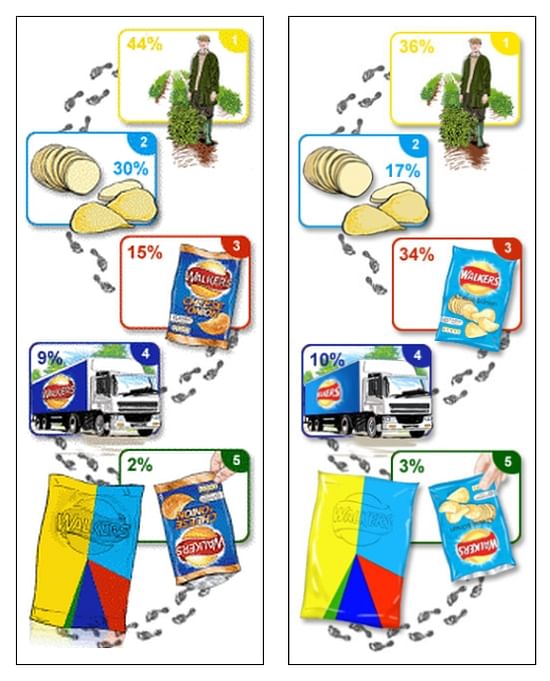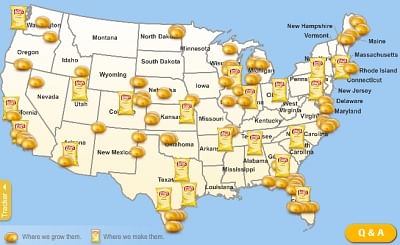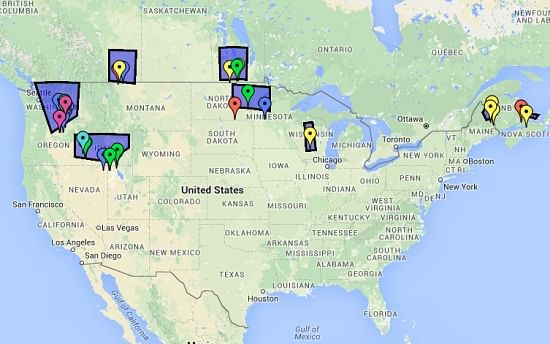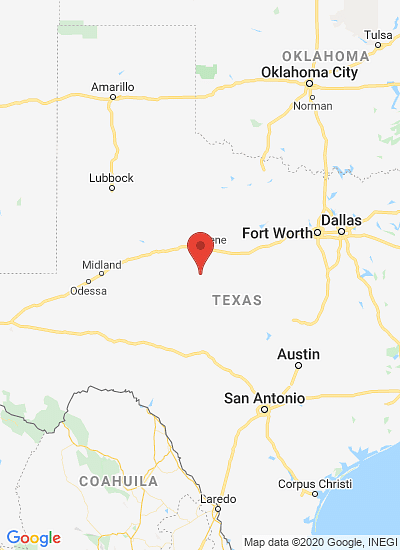The Frito-lay production locations and the locations of the potato growers supplying Frito-Lay with Potatoes.
Frito-Lay offers local potato chips

Recently Frito-Lay started a campaign in the United States to show consumers where their bag of Lays Chips was manufactured and even where the potatoes for that specific bag were grown: the Chips Tracker (no longer available).

The contribution of each stage in the production chain of Walkers Chips to the overall carbon footprint of the product.
The initially mentioned contributions of each stage to the total carbon footprint is shown at the left. Two years later, Walkers published the updated figures shown at the right.
The difference is the result of actual changes in the production process, but also as a result of changes in the way the carbon footprint was calculated, as a result of increasing insight and updated protocols.
Walkers claimed an overall reduction of 7% in carbon footprint in those two years, using comparable methods.
A Category Leader
Frito-Lay has always surprised me in a positive way in how they pick up trends and implement them, mostly before others do. They truly behave as a category leader. They are also good in communicating what they do to their customers and the world at large. Given their size, this should not come as much of a surprise, they can afford a good PR team.
Let’s look at Frito-Lay’s record:
- Frito-Lay brought “light” (OK, that wasn’t a success),
- they brought healthy oils,
- they were the first to calculate the carbon footprint of potato Chips.
- an entire new frying technology resulting in better low fat potato chips,
- they are bringing energy savings and alternative (solar) energy and
- biodegradable packaging.
How to interpret "Locally Grown and Produced"
I think the problem is that the ”Local” concept is interpreted in different ways:
- If “local” to you also means that farms and processor have to be small, Frito-Lay, with a global market share of the snack market of close to 30% does not come close and never will be a "local" manufacturer. Interesting detail: Did you notice that the farms profiled in the Frito-lay ads are NOT small? In fact they all seem large...
- If you feel that “local” also means that production has to be organic and in every way sustainable, than most of Frito-Lay’s farmers probably still have a long way to go.
- However, if you look at “local” in a more strict sense as minimizing the carbon footprint and environmental impact by reducing transportation distances and optimizing logistics, than Frito-Lay’s Chips certainly fits the "local" label.
The Logistics of the Potato Processing Chain
Let’s look a bit more in detail at the logistics in the potato processing Industry. Since we focus on local, let me start by sharing a well kept secret of the potato processing industry. ALL potato processors source their potatoes locally, with very few exceptions.
Most potato processing factories are located right in the middle of potato growing areas. The reason is basic economics: It is expensive to transport potatoes over long distances. Furthermore, transportation is detrimental to the quality of the potatoes, resulting in extra losses during the production process. There is even an extra advantage if potatoes are processed within 24 hours after harvest, since any bruising resulting from harvesting will not develop into black spots.
But the logistics not only comprise the transport of the potatoes to the factory, there is also the transport of the product to the consumer.
Here we see huge differences between potato products, mainly based on shelf life and density:
- Potato starch and dehydrated potato products like potato flakes and potato granules represent "potato in its most concentrated form" and are transported all over the world. Much of the potato starch in North America originates from Europe and China even found it necessary to slap an anti-dumping tax on European potato starch to reduce its import.
- Frozen French fries are exported all over the world as well, but transport and storage is more expensive, since the product needs to be kept frozen and you are also transporting considerable amounts of water.
- Potato chips on the other hand are not transported too far: Shelf life is limited and you are mainly transporting air. Risk of breakage further discourages transportation over long distances.
- Manufacturers of French Fries in Canada
- Manufacturers of French Fries in the United States
- Manufacturers of Potato Chips in Canada
- Manufacturers of Potato Chips in the United States
- START HERE.
- Drill down to the "Region" first, using the black "Smaller Region" button.
- Repeat, until you arrive at your region of interest
- Next, select the "Type of Product" if applicable
Frozen french fries can be transported much easier than potato chips, therefore the french fry factories are located where it is least expensive to grow and store (fall) potatoes.
On the other hand, Frito-lay's potato chip factories (represented by a bag) have a nice geographic spread to be minimize transportation of the products to all customers.

Frito-Lay Production locations in the United States as displayed as part of the "Chip Tracker"
The conclusion not everyone might like is that large companies with multiple factories have a definite advantage in optimizing their product logistics and can be more "local" in the narrow definition (3) I offered at the beginning.
Case and point made by Frito-Lay in their "Chip Tracker" campaign.


















